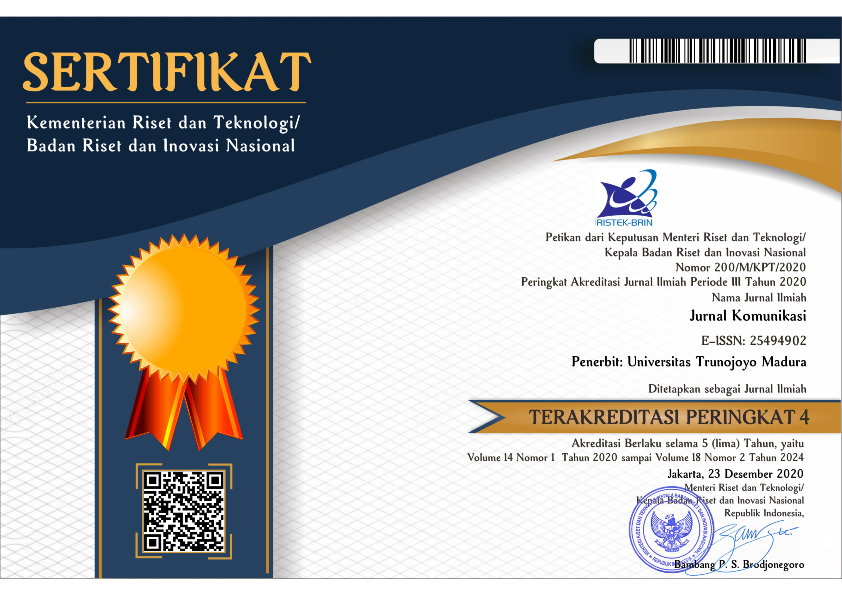Social Control or Public Image, When Mass Media and University-Owned Media Construct Narratives of Sexual Violence
Abstract
Sexual violence in higher education is a sensitive topic as well as a topic that attracts the most media attention. For example, in early 2022, the Dean of one of the faculties at Riau University (UNRI) was suspected of harassing his students during the implementation of final project guidance. Since it was reported, this case has grabbed attention, appeared in the corners of social media discussions, and become a discourse in the mass media. Many media outlets, especially online media, have attempted to revisit the public's memory of sexual violence cases in Indonesia's higher education environment, and how these campuses have handled the issue of sexual violence. On the other hand, several universities in Indonesia have tried to show their 'concern' for cases of sexual violence that have occurred in Indonesian universities through campus "news" portals. The question that arises then is whether the media concern narrated in media portal news and campus concern in campus portal news are similar forms of concern. This research tries to answer this question by managing the news of media portals and campus portals in relation to the news of sexual violence in the campus environment using a qualitative approach with a narrative analysis method by utilizing a narrative model developed from the thoughts of Todorov (1977) to define the structure and plot of news narratives, and Propp (1968) to dissect the construction of meaning through characterization. By looking at the structure and characterization in news narratives, it is hoped that it can answer how the phenomenon of sexual violence is narrated by media portals and campus portals and what interests are behind the news narratives of sexual violence published by media portals and campus portals.
Keywords
Full Text:
PDFReferences
Aristi, N., Janitra, P. A., & Prihandini, P. (2021). Fokus narasi kekerasan seksual pada portal berita daring selama pandemi COVID-19. Jurnal Kajian Komunikasi, 9(1), 121. https://doi.org/10.24198/jkk.v9i1.30673
Bennett, T., & Woollacott, J. (1987). Bond and beyond : the political career of a popular hero. In Communications and culture.
Berger, A. A. (1997). Narratives in popular culture, media, and everyday life. In Choice Reviews Online (Vol. 34). https://doi.org/10.5860/choice.34-3127
Berger, A. A. (2013). Media, myth, and society. In Media, Myth, and Society. https://doi.org/10.1057/9781137301673
Bondestam, F., & Lundqvist, M. (2020). Sexual harassment in higher education–a systematic review. European Journal of Higher Education, 10(4), 397–419. https://doi.org/10.1080/21568235.2020.1729833
Brusentsev, A., Hitchens, M., & Richards, D. (2012). An investigation of Vladimir Propp’s 31 functions and 8 broad character types and how they apply to the analysis of video games. ACM International Conference Proceeding Series. https://doi.org/10.1145/2336727.2336729
Clair, R. P., Brown, N. E., Dougherty, D. S., Delemeester, H. K., Geist-Martin, P., Gorden, W. I., … Turner, P. K. (2019). #MeToo, sexual harassment: an article, a forum, and a dream for the future. Journal of Applied Communication Research, 47(2), 111–129. https://doi.org/10.1080/00909882.2019.1567142
Eriyanto. (2002). Analisis framing: konstruksi, ideologi, dan politik media. LKiS. Retrieved from https://books.google.co.id/books?id=wGwj0CPSjlQC
Eriyanto. (2013a). Analisis Framing. Jakarta: Kencana Prenada Media Group.
Eriyanto. (2013b). Analisis Naratif : Dasar-Dasar dan Penerapannya dalam Analisis Teks Berita Media. Jakarta: Kencana.
Fulton, H., Huisman, R., Murphet, J., & Dunn, A. (2005). Narrative and Media. Cambridge: Cambridge University Press.
Hallin, D. C. (2005). We Keep America on Top of the World. New York: Routledge. https://doi.org/10.4324/9780203977477
Hardy, J. (2014). Critical political economy of communications: A mid-term review. International Journal of Media and Cultural Politics, 10(2), 189–202. https://doi.org/10.1386/macp.10.2.189_1
Hardy, J. (2017). Money, (Co)Production and Power: The contribution of critical political economy to digital journalism studies. Digital Journalism, 5(1), 1–25. https://doi.org/10.1080/21670811.2016.1152162
Indainanto, Y. I. (2020). Normalisasi Kekerasan Seksual Wanita di Media Online. Jurnal Komunikasi, 14(2), 105–118. https://doi.org/10.21107/ilkom.v14i2.6806
Indrasty, R., Wibawa, D., & Rojudin. (2018). Gender dalam Kasus Kekerasan terhadap Perempuan di Media Online. Jurnal Komunikasi Jurnalistik, 3, 90–112.
Kent, M. L. (2015). The power of storytelling in public relations: Introducing the 20 master plots. Public Relations Review, 41(4), 480–489. https://doi.org/10.1016/j.pubrev.2015.05.011
Kleemans, M., Schaap, G., & Suijkerbuijk, M. (2018). Getting Youngsters Hooked on News: The effects of narrative news on information processing and appreciation in different age groups. Journalism Studies, 19(14), 2108–2125.
https://doi.org/10.1080/1461670X.2017.1324316
Krisdinanto, N. (2014). Anomali dan Teori Hirarki Pengaruh terhadap Isi Media. Komunikatif, 3(1), 1–18.
Lacey, N. (2000). Narrative and Genre: Key Concepts in Media Studies. London: Macmillan.
Li, M. (2021). The Synergistic Effects of Solutions Journalism and Corporate Social Responsibility Advertising. Digital Journalism, 9(3), 336–363. https://doi.org/10.1080/21670811.2020.1840407
Nossek, H., & Berkowitz, D. (2006). Telling “Our” story through news of terrorism: Mythical newswork as journalistic practice in crisis. Journalism Studies, 7(5), 691–707. https://doi.org/10.1080/14616700600890356
Noviani P, utami zahirah, Arifah, R., Cecep, C., & Humaedi, S. (2018). Mengatasi Dan Mencegah Tindak Kekerasan Seksual Pada Perempuan Dengan Pelatihan Asertif. Prosiding Penelitian Dan Pengabdian Kepada Masyarakat, 5(1), 48. https://doi.org/10.24198/jppm.v5i1.16035
Propp, V. (1968). Morphology of the Folktale (2nd ed.; L. A. Wagner & A. Dundes, eds.). Austin, Texas: University of Texas Press.
Radita. (2019). Struktur Dan Fungsi Narasi Pemberitaan Penyerbuan Kelompok Terorisme Pada Media Massa Cetak.
Rokhman, S. (2018). Analisis Naratif Model Vladimir Prop Tentang Pemberitaan Demonstrasi Aksi Bela Islam II Pada Surat Kabar Media Indonesia. 1(2), 1–15.
Scarduzio, J. A., Redden, S. M., & Fletcher, J. (2021). Everyone’s ‘uncomfortable’ but only some people report: privacy management, threshold levels, and reporting decisions stemming from coworker online sexual harassment. Journal of Applied Communication Research, 49(1), 66–85. https://doi.org/10.1080/00909882.2020.1849771
Serazio, M. (2020). Making (Branded) News: The Corporate Co-optation of Online Journalism Production. Journalism Practice, 14(6), 679–696. https://doi.org/10.1080/17512786.2019.1637273
Shoemaker, P. J., & Reese, S. D. (2013). Mediating the message in the 21st century: A media sociology perspective (3rd ed.). New York: Routledge. https://doi.org/10.4324/9780203930434
Stefani, R., & Kurniawati, W. (2021). Analisis Fungsi Narasi Vladimir Propp dalam Kumpulan Dongeng Karya Brüder Grimm. 10(2), 94–104. Retrieved from R Stefani, W Kurniawati - ejournal.unesa.ac.id
Swart, J., Groot Kormelink, T., Costera Meijer, I., & Broersma, M. (2022). Advancing a Radical Audience Turn in Journalism. Fundamental Dilemmas for Journalism Studies. Digital Journalism, 10(1), 8–22. https://doi.org/10.1080/21670811.2021.2024764
Todorov, T. (1977). The Poetics of Prose (R. Howard, ed.). New York: Cornell University.
Van Krieken, K. (2020). Do Reconstructive and Attributive Quotes in News Narratives Influence Engagement, Credibility and Realism? Journalism Studies, 21(2), 145–161. https://doi.org/10.1080/1461670X.2019.1632735
Von Sikorski, C., & Saumer, M. (2021). Sexual Harassment in Politics. News about Victims’ Delayed Sexual Harassment Accusations and Effects on Victim Blaming: A Mediation Model. Mass Communication and Society, 24(2), 259–287. https://doi.org/10.1080/15205436.2020.1769136
Vos, T. P., Eichholz, M., & Karaliova, T. (2019). Audiences and Journalistic Capital: Roles of journalism. Journalism Studies, 20(7), 1009–1027. https://doi.org/10.1080/1461670X.2018.1477551
Yousuf, M., & Taylor, M. (2017). Helping Syrians Tell Their Story to The World: Training Syrian citizen journalists through connective journalism. Journalism Practice, 11(2–3), 302–318. https://doi.org/10.1080/17512786.2016.1218296
DOI: https://doi.org/10.21107/ilkom.v17i1.19463
Refbacks
- There are currently no refbacks.
Copyright (c) 2023 Theresia Intan Putri Hartiana, Putra Aditya Lapalelo, Nanang Krisdinanto

This work is licensed under a Creative Commons Attribution-ShareAlike 4.0 International License.
Jurnal Komunikasi by Universitas Trunojoyo Madura is licensed under a Creative Commons Attribution-ShareAlike 4.0 International License.















